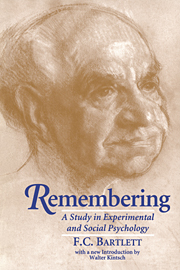Book contents
- Frontmatter
- Contents
- Biography of Sir Frederic C. Bartlett
- Introduction by Walter Kintsch
- Preface
- PART I EXPERIMENTAL STUDIES
- Chapter I Experiment in Psychology
- Chapter II Experiments on Perceiving
- Chapter III Experiments on Imaging
- Chapter IV Experiments on Remembering: (a) The Method of Description
- Chapter V Experiments on Remembering: (b) The Method of Repeated Reproduction
- Chapter VI Experiments on Remembering: (c) The Method of Picture Writing
- Chapter VII Experiments on Remembering: (d) The Method of Serial Reproduction; I
- Chapter VIII Experiments on Remembering: (e) The Method of Serial Reproduction; II. Picture Material
- Chapter IX Perceiving, Recognising, Remembering
- Chapter X A Theory of Remembering
- Chapter XI Images and their Functions
- Chapter XII Meaning
- PART II REMEMBERING AS A STUDY IN SOCIAL PSYCHOLOGY
- Index
- Plate section
Chapter III - Experiments on Imaging
Published online by Cambridge University Press: 04 August 2010
- Frontmatter
- Contents
- Biography of Sir Frederic C. Bartlett
- Introduction by Walter Kintsch
- Preface
- PART I EXPERIMENTAL STUDIES
- Chapter I Experiment in Psychology
- Chapter II Experiments on Perceiving
- Chapter III Experiments on Imaging
- Chapter IV Experiments on Remembering: (a) The Method of Description
- Chapter V Experiments on Remembering: (b) The Method of Repeated Reproduction
- Chapter VI Experiments on Remembering: (c) The Method of Picture Writing
- Chapter VII Experiments on Remembering: (d) The Method of Serial Reproduction; I
- Chapter VIII Experiments on Remembering: (e) The Method of Serial Reproduction; II. Picture Material
- Chapter IX Perceiving, Recognising, Remembering
- Chapter X A Theory of Remembering
- Chapter XI Images and their Functions
- Chapter XII Meaning
- PART II REMEMBERING AS A STUDY IN SOCIAL PSYCHOLOGY
- Index
- Plate section
Summary
INTRODUCTION AND METHOD
In one sense the whole of the subsequent experiments to be discussed in this book will deal with processes of imaging. For imaging consists essentially in the utilisation of experiences which are no longer fully presented to perceptual sensory organs, and such utilisation is a part of all remembering processes. But before discussing the exact ways in which imaging enters into remembering, it is necessary (a) to get as definite an idea as possible of precisely what should be included in imaging, and (b) to determine at least some of the most important of the general conditions and types of imagery.
The possibility of using ink-blots in the study of imagination was suggested by G. V. Dearborn, and used by him in a brief “Study of Imagination” Some other experimenters had already made use of this type of material, before I carried out the experiments which I am about to discuss, and since then similar ink-blots have been used by a number of investigators for various purposes. I prepared a series of blots, some of which are reproduced in the accompanying plates. Thirty-six blots were used in all. They were variously shaded or coloured, mounted on ordinary post-cards, and laid face downwards in front of the subjects. The instructions were: “Here are a number of ink-blots. They represent nothing in particular, but might recall almost anything. See what you can make of them, as you sometimes find shapes for clouds, or see faces in a fire”. The subjects turned over the cards for themselves.
- Type
- Chapter
- Information
- RememberingA Study in Experimental and Social Psychology, pp. 34 - 46Publisher: Cambridge University PressPrint publication year: 1995



